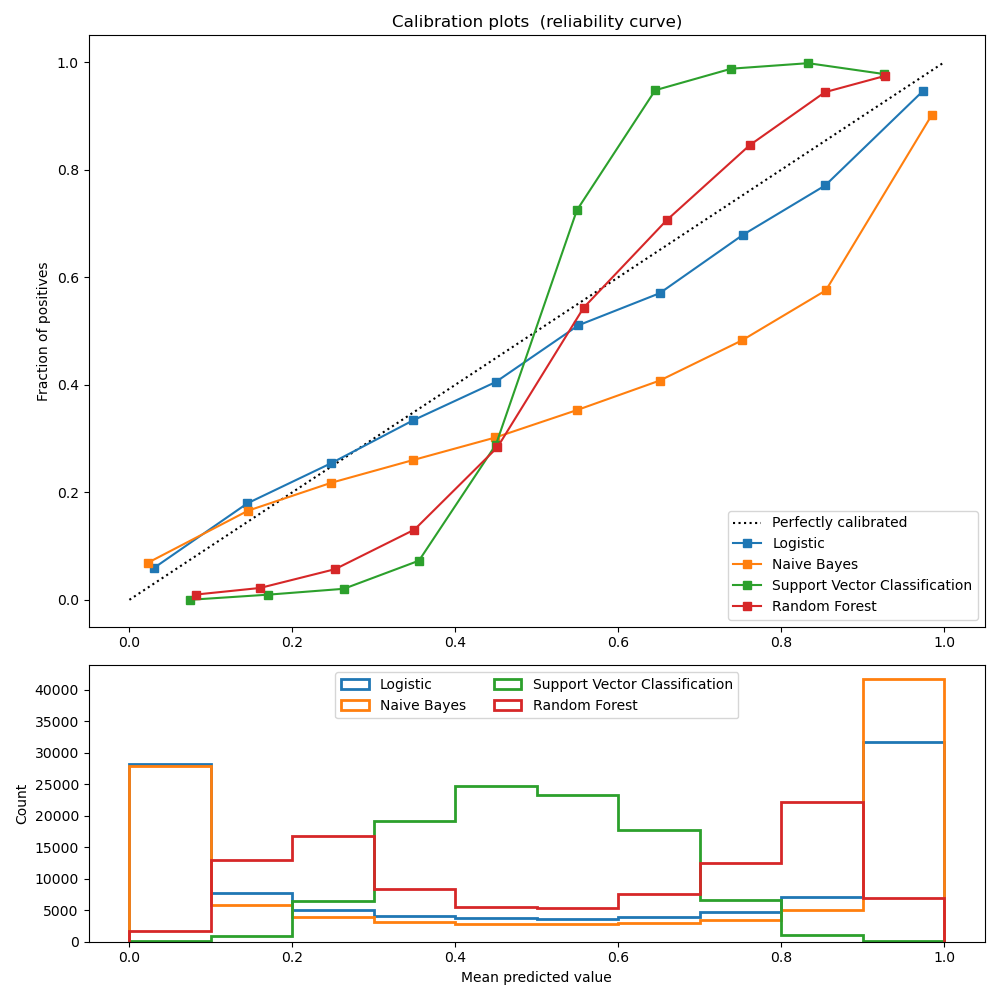1.16. Probability calibration¶
When performing classification you often want not only to predict the class label, but also obtain a probability of the respective label. This probability gives you some kind of confidence on the prediction. Some models can give you poor estimates of the class probabilities and some even do not support probability prediction. The calibration module allows you to better calibrate the probabilities of a given model, or to add support for probability prediction.
Well calibrated classifiers are probabilistic classifiers for which the output of the predict_proba method can be directly interpreted as a confidence level. For instance, a well calibrated (binary) classifier should classify the samples such that among the samples to which it gave a predict_proba value close to 0.8, approximately 80% actually belong to the positive class.
1.16.1. Calibration curves¶
The following plot compares how well the probabilistic predictions of
different classifiers are calibrated, using calibration_curve.
The x axis represents the average predicted probability in each bin. The
y axis is the fraction of positives, i.e. the proportion of samples whose
class is the positive class (in each bin).
LogisticRegression returns well calibrated predictions by default as it directly
optimizes log-loss. In contrast, the other methods return biased probabilities;
with different biases per method:
GaussianNB tends to push probabilities to 0 or 1 (note the counts
in the histograms). This is mainly because it makes the assumption that
features are conditionally independent given the class, which is not the
case in this dataset which contains 2 redundant features.
RandomForestClassifier shows the opposite behavior: the histograms
show peaks at approximately 0.2 and 0.9 probability, while probabilities
close to 0 or 1 are very rare. An explanation for this is given by
Niculescu-Mizil and Caruana 1: “Methods such as bagging and random
forests that average predictions from a base set of models can have
difficulty making predictions near 0 and 1 because variance in the
underlying base models will bias predictions that should be near zero or one
away from these values. Because predictions are restricted to the interval
[0,1], errors caused by variance tend to be one-sided near zero and one. For
example, if a model should predict p = 0 for a case, the only way bagging
can achieve this is if all bagged trees predict zero. If we add noise to the
trees that bagging is averaging over, this noise will cause some trees to
predict values larger than 0 for this case, thus moving the average
prediction of the bagged ensemble away from 0. We observe this effect most
strongly with random forests because the base-level trees trained with
random forests have relatively high variance due to feature subsetting.” As
a result, the calibration curve also referred to as the reliability diagram
(Wilks 1995 2) shows a characteristic sigmoid shape, indicating that the
classifier could trust its “intuition” more and return probabilities closer
to 0 or 1 typically.
Linear Support Vector Classification (LinearSVC) shows an even more
sigmoid curve as the RandomForestClassifier, which is typical for
maximum-margin methods (compare Niculescu-Mizil and Caruana 1), which
focus on hard samples that are close to the decision boundary (the support
vectors).
1.16.2. Calibrating a classifier¶
Calibrating a classifier consists in fitting a regressor (called a calibrator) that maps the output of the classifier (as given by predict or predict_proba) to a calibrated probability in [0, 1]. Denoting the output of the classifier for a given sample by \(f_i\), the calibrator tries to predict \(p(y_i = 1 | f_i)\).
The samples that are used to train the calibrator should not be used to train the target classifier.
1.16.3. Usage¶
The CalibratedClassifierCV class is used to calibrate a classifier.
CalibratedClassifierCV uses a cross-validation approach to fit both
the classifier and the regressor. For each of the k (trainset, testset)
couple, a classifier is trained on the train set, and its predictions on the
test set are used to fit a regressor. We end up with k
(classifier, regressor) couples where each regressor maps the output of
its corresponding classifier into [0, 1]. Each couple is exposed in the
calibrated_classifiers_ attribute, where each entry is a calibrated
classifier with a predict_proba method that outputs calibrated
probabilities. The output of predict_proba for the main
CalibratedClassifierCV instance corresponds to the average of the
predicted probabilities of the k estimators in the
calibrated_classifiers_ list. The output of predict is the class
that has the highest probability.
The regressor that is used for calibration depends on the method
parameter. 'sigmoid' corresponds to a parametric approach based on Platt’s
logistic model 3, i.e. \(p(y_i = 1 | f_i)\) is modeled as
\(\sigma(A f_i + B)\) where \(\sigma\) is the logistic function, and
\(A\) and \(B\) are real numbers to be determined when fitting the
regressor via maximum likelihood. 'isotonic' will instead fit a
non-parametric isotonic regressor, which outputs a step-wise non-decreasing
function (see sklearn.isotonic).
An already fitted classifier can be calibrated by setting cv="prefit". In
this case, the data is only used to fit the regressor. It is up to the user
make sure that the data used for fitting the classifier is disjoint from the
data used for fitting the regressor.
CalibratedClassifierCV can calibrate probabilities in a multiclass
setting if the base estimator supports multiclass predictions. The classifier
is calibrated first for each class separately in a one-vs-rest fashion 4.
When predicting probabilities, the calibrated probabilities for each class
are predicted separately. As those probabilities do not necessarily sum to
one, a postprocessing is performed to normalize them.
The sklearn.metrics.brier_score_loss may be used to evaluate how
well a classifier is calibrated.
Examples:
References:
- 1(1,2)
Predicting Good Probabilities with Supervised Learning, A. Niculescu-Mizil & R. Caruana, ICML 2005
- 2
On the combination of forecast probabilities for consecutive precipitation periods. Wea. Forecasting, 5, 640–650., Wilks, D. S., 1990a
- 3
Probabilistic Outputs for Support Vector Machines and Comparisons to Regularized Likelihood Methods, J. Platt, (1999)
- 4
Transforming Classifier Scores into Accurate Multiclass Probability Estimates, B. Zadrozny & C. Elkan, (KDD 2002)

